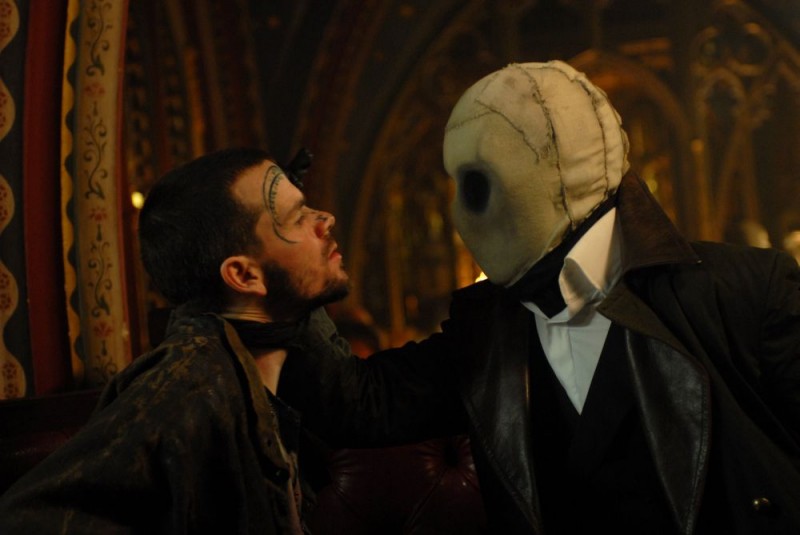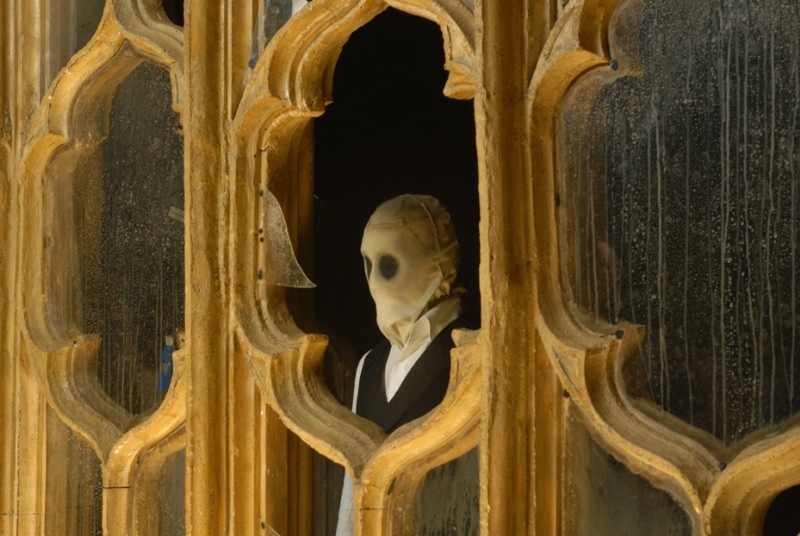It is often that one is confronted with the biggest, hardest questions regarding faith: is there something to believe in?
How can we be sure we are being watched over when the things we cherish can be taken away without a moment’s notice? How can evil be permitted to exist if our deity is the embodiment of good? These and much more often plague our lives, but to see what would happen if they swallowed us whole, we take a look at Gerard McMorrow’s “Franklyn.”
Meanwhile City Blues
Jonathan (John) Preest is in a predicament: he resides in Meanwhile City, a gothic, often steampunk-ish metropolis where the only law is that you must belong to a religion. But Preest, having lost his faith, is an atheist, which is why he is some sort of a masked vigilante. He is after a religious leader named the Individual, whose religion, Duplex Ride, destroyed the life of (and, also, killed) a little girl he was trying to protect. He intends to assassinate the Individual, but to do so, he must navigate the twisted, over-zealous landscape of Meanwhile City.
On the other side of the looking glass, in the world that we know, several individuals are moving through their lives. Peter Esser, a Cambridge church warden and thus a man of faith, comes to London, looking for his son, David. Emilia, an art student whose projects often center around committing suicide and having the paramedics save her, is trying to run from a past that’s as much part of her as her present. And finally, Milo, heartbroken over being left just before he reached the altar, finds himself getting reacquainted with an old childhood friend, who seems to give him, as she has before, the fulfillment and balance that he needs.
As John Preest draws closer to his goal, Peter draws closer to finding David, Emilia’s tightly-wound self begins to come unraveled and Milo begins to discover just how deep his desolation goes. The one bullet Preest means for the Individual is bound, unbeknownst to anyone, to change everything.
© celluloidwordslick.blogspot.com
Out in the Real World
“Franklyn” consists of these four separate stories, three of them taking place in this world and the third in the strange realm of Meanwhile City, moving closer to one another despite having little to do with each other, except perhaps to share a theme. That theme, while extremely present, however, is buried underneath the stunning visual language of “Franklyn.”
Let us start with the fantastical. Meanwhile City is depicted as a, as said before, gothic steampunk-like metropolis overwhelmed with strange and often ridiculous religions. The city itself is magnificently shown – gothic arches, statues, high-rise, stone buildings sprawling out in all directions, carrying a fantastic, yet historic feel. The point that the city was built upon religion is effortlessly depicted: the streets of Meanwhile City are filled to the brim with the faithful, carrying their icons, performing their rituals, preaching their faiths. One aside features a man giving a sermon by reciting washing machine instructions (by outlining how coins and metal objects shouldn’t be put in the machine.) A clerk at the faith registry (Meanwhile City’s main hall of records) says that she is currently with the “Seventh Day Manicurists.” Preest mostly flies under the radar, but some people that he must interact with (like the weasel-like bottom-feeder Snakes) know that he lacks the one thing that is required of Meanwhile City’s inhabitants.
The real world, on the other hand, is dull, dreary and bleak. The streets and parks are depicted as lifeless, hollow – much like graveyards are often thought of. The interiors fare no better: Emilia’s house is a lush, slightly-gothic coffin, and the hospital she often inhabits is a sterile, paste-white box of benches and tables and off-white gowns. Peter’s search often take him into rooms that, while warmer slightly, are still closed-off, walled-in spaces where there is little room for wondering why people dwell within them. In fact, the same goes for Emilia, where the other rooms that she transitions between often serve as a confined space where she can just avoid actually talking to whoever she’s in there with. Milo’s story often contrasts this bleakness with the relative warmth of households where the presence of two or more people is something that makes it a human space: namely, the house of two of his (married) friends, and his mother’s house.
© franklynmoviejam-packedwith.typepad.com
You’ve Gotta Have Faith
The plot progression basically centers on the idea of faith, and what the loss of it, or rather, the complete absence of it can create. John Preest, in his almost single-minded search for the end of the Individual, once philosophizes: “If a god is willing to prevent evil, but not able, then he’s not omnipotent. If he is able, but not willing, then he must be malevolent. If he is neither able nor willing, why call him a god?”
The loss of faith, rather than the often underlying idea that it is needed, is a central theme in “Franklyn.” In fact, all but one of the characters (Peter) can be said to have lost their faith and/or their will to believe. John Preest’s status as the only atheist in a city of countless religions, mostly due to his unanswered question of “Why else do bad things happen to good people?” explains the basic reason behind the said loss of faith – that tragedies and traumas suffered often have no rhyme or reason to them, and when unable to explain why one might have “deserved” such a fate (which, ironically, signals faith in fate) one can only cope with what has transpired by turning away from faith. Returning to Preest, his single-minded animosity towards the Individual isn’t because he is faithless; had that been the case, he wouldn’t have enough bullets to bring down the religious leaders roaming Meanwhile City. Preest views faith as something destructive, something that took the life of a little girl, which is a testament to the evil hidden (or rather, can be inserted) in(to) the concept.
On the other hand, in the real world, Milo’s loss of faith isn’t something that he treats as being contrary to anything – he simply does not believe that he will be able to find someone he can be happy with. However, he isn’t an unbeliever, per se, he is simply lost. Emilia, in stark contrast, does not have faith in anything at all. She is stuck in her routine of fighting with her mother, repeatedly killing herself and surviving, and annoying her professors. Her lack of faith in anything not just in particular but at all is not responsible for the rut she’s in, but in keeping mostly with Preest’s perception of faith, it is shown that faith isn’t the thing that can save her. As for Peter, the only one in this bunch to actually have faith, he is isolated by it. It is mentioned that his wife believes him deluded for believing in the idea that it was God’s will that the tragedy that broke David occurred, just as it is God’s will (i.e. faith) that can pull him back. It can be said that Peter is Preest’s foil and proof. He is a testament to how faith is a futile and often dangerous thing, and while nigh-inevitable, ultimately hollow. Of course, the movie subtly positions itself to share and reinforce Preest’s bias, regarding the issue.
One Bullet to Change Everything
“Franklyn” is an interesting and impressive watch. Its impressive visuals, which, I will admit to liking so much due to my affection for dark, bleak atmospheres, are nevertheless stunning in their own right. The main issue most people take is with “Franklyn”s pacing, as it is not a very fast-paced movie, however, its main strength is in its rather calm, yet not slow progression. The basic concept of a single bullet shot in a strange realm changing the lives of completely unrelated people, while not entirely new, is driven sublimely and the payoff to the long build-up is worth it. If I may be so blunt, “Franklyn”, in short, is a very underrated film.






